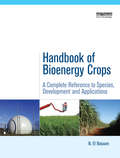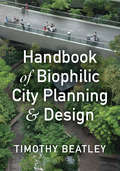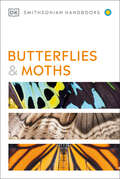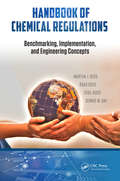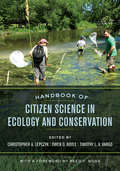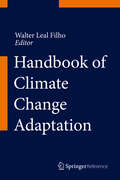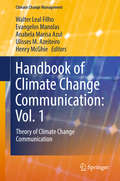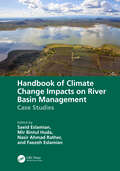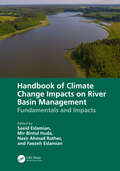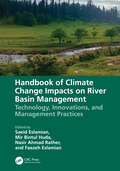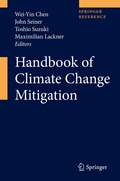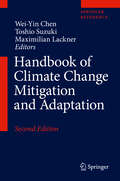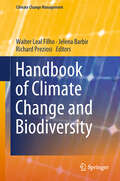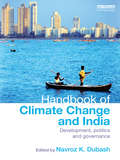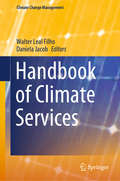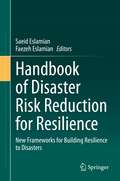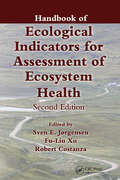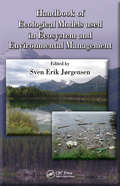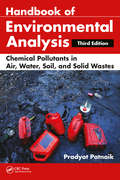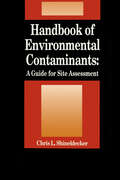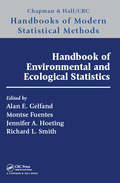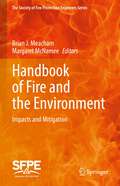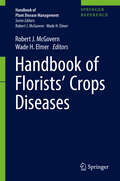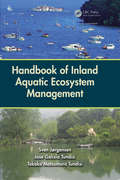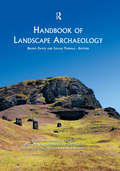- Table View
- List View
Handbook of Bioenergy Crops: A Complete Reference to Species, Development and Applications (Routledge Studies in Bioenergy)
by N. El BassamBiomass currently accounts for about fifteen per cent of global primary energy consumption and is playing an increasingly important role in the face of climate change, energy and food security concerns. Handbook of Bioenergy Crops is a unique reference and guide, with extensive coverage of more than eighty of the main bioenergy crop species. For each it gives a brief description, outlines the ecological requirements, methods of propagation, crop management, rotation and production, harvesting, handling and storage, processing and utilization, then finishes with selected references. This is accompanied by detailed guides to biomass accumulation, harvesting, transportation and storage, as well as conversion technologies for biofuels and an examination of the environmental impact and economic and social dimensions, including prospects for renewable energy. This is an indispensable resource for all those involved in biomass production, utilization and research.
Handbook of Biophilic City Planning & Design
by Timothy BeatleyWhat if, even in the heart of a densely developed city, people could have meaningful encounters with nature? While parks, street trees, and green roofs are increasingly appreciated for their technical services like stormwater reduction, from a biophilic viewpoint, they also facilitate experiences that contribute to better physical and mental health: natural elements in play areas can lessen children's symptoms of ADHD, and adults who exercise in natural spaces can experience greater reductions in anxiety and blood pressure.The Handbook of Biophilic City Planning & Design offers practical advice and inspiration for ensuring that nature in the city is more than infrastructure--that it also promotes well-being andcreates an emotional connection to the earth among urban residents. Divided into six parts, the Handbook begins by introducing key ideas, literature, and theory about biophilic urbanism. Chapters highlight urban biophilic innovations in more than a dozen global cities. The final part concludes with lessons on how to advance an agenda for urban biophilia and an extensive list of resources.As the most comprehensive reference on the emerging field of biophilic urbanism, the Handbook is essential reading for students and practitioners looking to place nature at the core of their planning and design ideas and encourage what preeminent biologist E.O. Wilson described as "the innate emotional connection of humans to all living things."
Handbook of Butterflies and Moths (DK Handbooks)
by David CarterA compact, comprehensive field guide to over 500 butterfly and moth species from around the world.The clearest and sharpest recognition guide to over 500 butterfly and moth species from around the world. Authoritative text, crystal-clear photography, and a systematic approach make this the most comprehensive and concise pocket guide to the butterflies and moths of the world. Packed with more than 600 full-colour photographs of over 500 species, this handy reference book is designed to cut through the process of identification and help you to recognize a species quickly and easily. Expertly written and thoroughly vetted, each entry combines a precise description with annotated photographs to highlight the characteristics and distinguishing features of each butterfly or moth, while also providing at-a-glance facts for quick reference. The introduction explains the difference between butterflies and moths, details the life cycle from egg to adult, rearing your own specimens, and offers guidance for finding and observing live specimens in the wild. A concise glossary defines technical and scientific terms. Compact enough to take out into the field, DK Handbooks: Butterflies & Moths makes identifying these beautiful insects easier than ever before.
Handbook of Chemical Regulations: Benchmarking, Implementation, and Engineering Concepts
by Martha J. Boss Brad Boss Cybil Boss Dennis W. DayThe first book of its kind, Handbook of Chemical Regulations: Benchmarking, Implementation, and Engineering Concepts introduces the concept of global harmonization and interlinks between regulations and examines the reasons behind major requirements for chemical manufacture, article production, and distribution, importation, and usage. A compendium
Handbook of Citizen Science in Ecology and Conservation
by Christopher A. Lepczyk Owen D. Boyle Timothy L. V. VargoHandbook of Citizen Science in Ecology and Conservation is the first practical and comprehensive manual for creating, implementing, or improving natural science research and monitoring projects that involve collaboration between scientists and the general public. As citizen science projects become increasingly common, project leaders are seeking information on concrete best practices for planning and implementing projects—practices that allow them to guide and gauge success while also ensuring the collection of high-quality data and rewarding experiences for volunteers. In this handbook, citizen science practitioners from around the world and with decades of experience provide step-by-step instructions, insights, and advice, and they explore real-world applications through case studies from a variety of citizen science projects. This is the definitive reference guide for anyone interested in starting or improving a citizen science project with ecological or conservation applications, from professors and graduate students to agency staff and nongovernmental organizations.
Handbook of Climate Change Adaptation
by Walter Leal FilhoThe Handbook of Climate Change Adaptation addresses the scientific, social, political and cultural aspects of climate change in an integrated and coherent way. The multi-volume reference focuses on one of the key aspects of climate change: adaptation and how to handle its impacts on physical, biotic and human systems, analyzing the social and normative scientific concerns and presenting the tools, approaches and methods aimed at management of climate change impacts. The high-quality, interdisciplinary contributions provides state-of-the-art descriptions of the topics at hand with the collective aim of offering, for a broad readership, an authoritative, balanced and accessible presentation of the best current understanding of the nature and challenges posed by climate change. It serves not only as a valuable information source but also as a tool to support teaching and research and as help for professionals to assist in decision-making.
Handbook of Climate Change Communication: Vol. 1
by Walter Leal Filho Ulisses M. Azeiteiro Anabela Marisa Azul Evangelos Manolas Henry McGhieThis comprehensive handbook provides a unique overview of the theory, methodologies and best practices in climate change communication from around the world. It fosters the exchange of information, ideas and experience gained in the execution of successful projects and initiatives, and discusses novel methodological approaches aimed at promoting a better understanding of climate change adaptation. Addressing a gap in the literature on climate change communication and pursuing an integrated approach, the handbook documents and disseminates the wealth of experience currently available in this field. Volume 1 of the handbook provides a unique description of the theoretical basis and of some of the key facts and phenomena which help in achieving a better understanding of the basis of climate change communication, providing an essential basis for successful initiatives in this complex field.
Handbook of Climate Change Impacts on River Basin Management: Case Studies
by Saeid Eslamian, Mir Bintul Huda, Nasir Ahmad Rather, and Faezeh EslamianClimate change not only involves rising temperatures but it can also alter the hydro-meteorological parameters of a region and the corresponding changes emerging in the various biotic or abiotic environmental features.One of the results of climate change has been the impact on the sediment yield and its transport. These changes have implications for various other environmental components, particularly soils, water bodies, water quality, land productivity, sedimentation processes, glacier dynamics, and risk management strategies to name a few.This volume presents a diverse collection of case studies from researchers across the globe examining the impacts of climate change on river basin management in various geographical, hydrological, and socioeconomic contexts. The case studies yield important insights that can inform strategies to build resilience and adapt river basins to a changing climate.
Handbook of Climate Change Impacts on River Basin Management: Fundamentals and Impacts
by Saeid Eslamian, Mir Bintul Huda, Nasir Ahmad Rather, and Faezeh EslamianClimate change not only involves rising temperatures but it can also alter the hydro-meteorological parameters of a region and the corresponding changes emerging in the various biotic or abiotic environmental features.One of the results of climate change has been the impact on the sediment yield and its transport. These changes have implications for various other environmental components, particularly soils, water bodies, water quality, land productivity, sedimentation processes, glacier dynamics, and risk management strategies to name a few.This volume provides an overview of the fundamental processes and impacts of climate change on river basin management and examines issues related to soil erosion, sedimentation, and contaminants, as well as rainfall-runoff modeling and flood mitigation strategies. It also includes coverage of climate change fundamentals as well as chapters on related global treaties and policies.
Handbook of Climate Change Impacts on River Basin Management: Technology, Innovations and Management Practices
by Saeid Eslamian, Mir Bintul Huda, Nasir Ahmad Rather, and Faezeh EslamianClimate change not only involves rising temperatures but it can also alter the hydro-meteorological parameters of a region and the corresponding changes emerging in the various biotic or abiotic environmental features.One of the results of climate change has been the impact on the sediment yield and its transport. These changes have implications for various other environmental components, particularly soils, water bodies, water quality, land productivity, sedimentation processes, glacier dynamics, and risk management strategies to name a few.This volume provides an examination of the technological approaches to water management, and the practical applications for remote sensing, satellite image processing, and advanced statistical methods, all which can be utilized to predict, monitor, and manage the effects of climate change on river basins.
Handbook of Climate Change Mitigation
by Maximilian Lackner Toshio Suzuki Wei-Yin Chen John SeinerThere is a mounting consensus that human behavior is changing the global climate and its consequence could be catastrophic. Reducing the 24 billion metric tons of carbon dioxide emissions from stationary and mobile sources is a gigantic task involving both technological challenges and monumental financial and societal costs. The pursuit of sustainable energy resources, environment, and economy has become a complex issue of global scale that affects the daily life of every citizen of the world. The present mitigation activities range from energy conservation, carbon-neutral energy conversions, carbon advanced combustion process that produce no greenhouse gases and that enable carbon capture and sequestion, to other advanced technologies. From its causes and impacts to its solutions, the issues surrounding climate change involve multidisciplinary science and technology. This handbook will provide a single source of this information. The book will be divided into the following sections: Scientific Evidence of Climate Change and Societal Issues, Impacts of Climate Change, Energy Conservation, Alternative Energies, Advanced Combustion, Advanced Technologies, and Education and Outreach.
Handbook of Climate Change Mitigation and Adaptation
by Maximilian Lackner Toshio Suzuki Wei-Yin ChenThe second edition of this important work covers additional topics of climate change mitigation and adaption strategies. It expands the scope of the first edition in the areas of mitigation and adds important new information on adaptation to climate change. Since the publication of the first edition, important new research findings have been gathered and natural events have continued to highlight the need for action.
Handbook of Climate Change and Biodiversity (Climate Change Management Ser.)
by Walter Leal Filho Jelena Barbir Richard PreziosiThis book comprehensively describes essential research and projects on climate change and biodiversity. Moreover, it includes contributions on how to promote the climate agenda and biodiversity conservation at the local level. Climate change as a whole and global warming in particular are known to have a negative impact on biodiversity in three main ways. Firstly, increases in temperatures are detrimental to a number of organisms, especially those in sensitive habitats such as coral reefs and rainforests. Secondly, the pressures posed by a changing climate may lead to sets of responses in areas as varied as phenology, range and physiology of living organisms, often leading to changes in their lifecycles (especially but not only in reproduction), losses in productivity or even death. In some cases, the very survival of very sensitive species may be endangered. Thirdly, the impacts of climate change on biodiversity will be felt in the short term with regard to some species and ecosystems, but also in the medium and long term in many biomes. Indeed, if left unchecked, some of these impacts may be irreversible. Many individual governments, financial institutes and international donors are currently spending billions of dollars on projects addressing climate change and biodiversity, but with little coordination. Quite often, the emphasis is on adaptation efforts, with little emphasis on the connections between physio-ecological changes and the lifecycles and metabolisms of fauna and flora, or the influence of poor governance on biodiversity. As such, there is a recognized need to not only better understand the impacts of climate change on biodiversity, but to also identify, test and implement measures aimed at managing the many risks that climate change poses to fauna, flora and micro-organisms. In particular, the question of how to restore and protect ecosystems from the impact of climate change also has to be urgently addressed. This book was written to address this need. The respective papers explore matters related to the use of an ecosystem-based approach to increase local adaptation capacity, consider the significance of a protected areas network in preserving biodiversity in a changing northern European climate, and assess the impacts of climate change on specific species, including wild terrestrial animals. The book also presents a variety of case studies such as the Yellowstone to Yukon Conservation Initiative, the effects of climate change on the biodiversity of Aleppo pine forest in Senalba (Algeria), climate change and biodiversity response in the Niger Delta region, and the effects of forest fires on the biodiversity and the soil characteristics of tropical peatlands in Indonesia. This is a truly interdisciplinary publication, and will benefit all scholars, social movements, practitioners and members of governmental agencies engaged in research and/or executing projects on climate change and biodiversity around the world.
Handbook of Climate Change and India: Development, Politics and Governance (Routledge Environment and Sustainability Handbooks)
by Navroz K. DubashHow do policymakers, businesses and civil society in India approach the challenge of climate change? What do they believe global climate negotiations will achieve and how? And how are Indian political and policy debates internalizing climate change? Relatively little is known globally about internal climate debate in emerging industrializing countries, but what happens in rapidly growing economies like India’s will increasingly shape global climate change outcomes. This Handbook brings together prominent voices from India, including policymakers, politicians, business leaders, civil society activists and academics, to build a composite picture of contemporary Indian climate politics and policy. One section lays out the range of positions and substantive issues that shape Indian views on global climate negotiations. Another delves into national politics around climate change. A third looks at how climate change is beginning to be internalized in sectoral policy discussions over energy, urbanization, water, and forests. The volume is introduced by an essay that lays out the critical issues shaping climate politics in India, and its implications for global politics. The papers show that, within India, climate change is approached primarily as a developmental challenge and is marked by efforts to explore how multiple objectives of development, equity and climate mitigation can simultaneously be met. In addition, Indian perspectives on climate negotiations are in a state of flux. Considerations of equity across countries and a focus on the primary responsibility for action of wealthy countries continue to be central, but there are growing voices of concern on the impacts of climate change on India. How domestic debates over climate governance are resolved in the coming years, and the evolution of India’s global negotiation stance are likely to be important inputs toward creating shared understandings across countries in the years ahead, and identify ways forward. This volume on the Indian experience with climate change and development is a valuable contribution to both purposes.
Handbook of Climate Services (Climate Change Management)
by Walter Leal Filho Daniela JacobThis book explores climate services, including projections, descriptive information, analyses, assessments, and an overview of current trends. Due to the pressures now being put on the world’s climate, it is vital to gather and share reliable climate observation and projection data, which may be tailored for use by different groups. In other words, it is essential to offer climate services. But despite the growth in the use of these services, there are very few specialist publications on this topic. This book addresses that need. Apart from presenting studies and the results of research projects, the book also offers an overview of the wide range of means available for providing and using climate services. In addition, it features case studies that provide illustrative and inspiring examples of how climate services can be optimally deployed.
Handbook of Disaster Risk Reduction for Resilience: New Frameworks for Building Resilience to Disasters
by Saeid Eslamian Faezeh EslamianThis book is part of a six-volume series on Disaster Risk Reduction and Resilience. The series aims to fill in gaps in theory and practice in the Sendai Framework, and provides additional resources, methodologies and communication strategies to enhance the plan for action and targets proposed by the Sendai Framework. The series will appeal to a broad range of researchers, academics, students, policy makers and practitioners in engineering, environmental science and geography, geoscience, emergency management, finance, community adaptation, atmospheric science and information technology. This volume discusses how to measure and build disaster resilience at society’s capacity, drawing upon individual, institutional and collective resources to cope with and adapt to the demands and challenges of natural disaster occurrences. The book will serve as a guide, outlining the key indicators of disaster resilience in urban and rural settings, and the resources and strategies needed to build resilient communities in accordance with the targets of the Sendai Framework. Readers will learn about multi-risk reduction approaches using computational methods, data mining techniques, and System Thinking at various scales, as well as institutional and infrastructure resilience strategies based on several case studies.
Handbook of Ecological Indicators for Assessment of Ecosystem Health
by Sven E. Jørgensen; Fu-Liu Xu; Robert CostanzaContinuing in the tradition of its bestselling predecessor, the Handbook of Ecological Indicators for Assessment of Ecosystem Health, Second Edition brings together world-class editors and contributors who have been at the forefront of ecosystem health assessment research for decades, to provide a sound approach to environmental management and sust
Handbook of Ecological Models used in Ecosystem and Environmental Management (Applied Ecology and Environmental Management)
by Sven Erik JørgensenIt is estimated that roughly 1000 new ecological and environmental models join the ranks of the scientific literature each year. The international peer-reviewed literature reports some 20,000 new models spanning the period from 1970-2010. Just to keep abreast of the field it is necessary to design a handbook of models that doesn't merely list them,
Handbook of Environmental Analysis: Chemical Pollutants in Air, Water, Soil, and Solid Wastes, Third Edition
by Pradyot PatnaikThe Handbook will cover all aspects of environmental analysis and will examine the emergence of many new classes of pollutants in recent years. It will provide information on an array of topics from instrumentation, analytical techniques, and sample preparations to statistical calculations, chemical structures, and equations. It will present the tools and techniques required to measure a wide range of toxic pollutants in our environment. It will be fully revised throughout, and will add four new chapters (Microbial Analysis, Chlorophyll, Chlorine, Chloramines and Chlorine Dioxide, and Derivatization Reactions in Environmental Analysis).
Handbook of Environmental Contaminants: A Guide for Site Assessment
by Chris ShineldeckerHandbook of Environmental Contaminants: A Guide for Site Assessment is an indispensable working reference for environmental assessment professionals faced with determining potential environmental contaminants that might be found in the soil, groundwater, or air of a property or facility. The book provides a comprehensive listing of potential contaminants associated with hundreds of industries, activities, and processes. The types of properties covered range from agricultural to heavy industrial. The products and processes covered range from the processing of yeast to the constituents of rocket fuel. The book also discusses products associated with the degradation of common chemical solvents in the environment.Handbook of Environmental Contaminants: A Guide for Site Assessment is an important reference for environmental consultants, workers on Superfund sites, public health and safety professionals, attorneys, educators and students, and lenders.
Handbook of Environmental and Ecological Statistics (ISSN)
by Alan Gelfand; Montse Fuentes; Jennifer A. Hoeting; Richard L. SmithThis handbook focuses on the enormous literature applying statistical methodology and modelling to environmental and ecological processes. The 21st century statistics community has become increasingly interdisciplinary, bringing a large collection of modern tools to all areas of application in environmental processes. In addition, the environmental community has substantially increased its scope of data collection including observational data, satellite-derived data, and computer model output. The resultant impact in this latter community has been substantial; no longer are simple regression and analysis of variance methods adequate. The contribution of this handbook is to assemble a state-of-the-art view of this interface. Features: An internationally regarded editorial team. A distinguished collection of contributors. A thoroughly contemporary treatment of a substantial interdisciplinary interface. Written to engage both statisticians as well as quantitative environmental researchers. 34 chapters covering methodology, ecological processes, environmental exposure, and statistical methods in climate science.
Handbook of Fire and the Environment: Impacts and Mitigation (The Society of Fire Protection Engineers Series)
by Brian J. Meacham Margaret McNameeThe fundamental purpose of this handbook is to raise awareness about environmental impacts of fire and fire suppression, primarily within the fire engineering and firefighting communities, but also within the environmental engineering and planning disciplines. The Handbook provides readers with a fundamental understanding of the problem and its magnitude and includes a set of tools and methods for assessing environmental, social and financial impacts, and a set of tools for identifying and selecting appropriate mitigation options.
Handbook of Florists' Crops Diseases
by Robert J. McGovern Wade H. ElmerChapters outline up-to-date strategies regarding breeding, chemical and biological control, cultural and environmental manipulation, diagnosis, nutrition, and sanitation and how these approaches directly influence ornamental plant health. This book is a presentation of the latest techniques for disease management by a global team of experts. The book addresses the major diseases of economically important ornamentals with the goal of capturing the latest disease management strategies along with diagnostic photographs. Florists' crops production has evolved considerably through new technological advances in irrigation, environmental control, along with the appearance of new centers of large scale production of plant material. These changes have necessitated the development of newer and innovative ways of suppressing pathogenic fungi, bacteria, viruses, and nematodes.
Handbook of Inland Aquatic Ecosystem Management
by Sven Jorgensen Jose Galizia Tundisi Takako Matsumura TundisiCombining background knowledge and practical tools, Handbook of Inland Aquatic Ecosystem Management gives you an overview of how to manage inland waters in a holistic manner. It examines the problems that threaten aquatic inland water ecosystems and presents a set of toolboxes for solving them. The book focuses on lakes, reservoirs, ponds, rivers,
Handbook of Landscape Archaeology (World Archaeological Congress Research Handbooks Ser. #1)
by Julian Thomas Bruno DavidOver the past three decades, "landscape" has become an umbrella term to describe many different strands of archaeology. From the processualist study of settlement patterns to the phenomenologist's experience of the natural world, from human impact on past environments to the environment's impact on human thought, action, and interaction, the term has been used. In this volume, for the first time, over 80 archaeologists from three continents attempt a comprehensive definition of the ideas and practices of landscape archaeology, covering the theoretical and the practical, the research and conservation, and encasing the term in a global framework. As a basic reference volume for landscape archaeology, this volume will be the benchmark for decades to come. All royalties on this Handbook are donated to the World Archaeological Congress.
